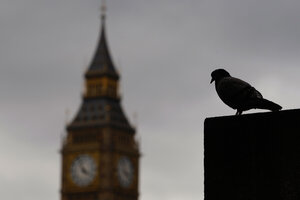How pigeons with tiny backpacks can help London curb pollution
Racing pigeons wearing small backpacks are putting their homing abilities to work as part of a campaign to raise awareness of London's poor air quality.

A pigeon perches on a plinth opposite the Houses of Parliament on an overcast summer's day in London, Aug. 4, 2009. Racing pigeons wearing small backpacks are putting their homing abilities to work as part of a campaign to raise awareness of London's poor air quality.
Andrew Winning/Reuters
That most urban of birds is now at work measuring the air quality over the famously smoky city of London.
Engineers at technology company Plume Labs trained 10 racing pigeons to wear tiny, specially designed backpacks full of equipment for measuring nitrogen dioxide and ozone. They are carefully attended by a veterinarian and trained to fly at strategic heights over London during rush hour. Perhaps unsurprisingly, they tweet results of the air tests upon request.
The three-day campaign – ending Wednesday – asks Londoners to help gather detailed, on-the-go, air-quality information by wearing similar sensing technology after the pigeons finish their rounds.
Dr. Edward Wasserman, who has researched pigeons extensively at the Comparative Cognition Laboratory at the University of Iowa, says this publicity stunt is hardly the most innovative use of pigeons, which have been exploited for their homing abilities for thousands of years.
"Pigeons have, after all, been shown to be able to recognize individual human faces and discriminate among pieces of art, Monet versus Picasso," Dr. Wasserman says. "In terms of keeping them in laboratories, they’re great. They can do it all."
He says the pigeon's lab career began after World War II, when psychologist B.F. Skinner trained the birds to guide missiles toward enemy ships. In London, some medical labs have used them to carry blood samples back and forth from the hospital. He has studied their ability to read medical reports, which shows they can memorize how different images ought to look and sometimes tell the difference between them, according to NBC News.
"They’re a pleasure to work with," Wasserman says. "They’re easily kept and they live a long time."
This is hardly the first time pigeons have donned a uniform in the service of mankind. They carried messages across battle lines for the British forces during World War I, and Paul Julius Reuter, founder of the news agency of that name, used their carrier abilities to transmit stock information between Brussels and Aachen before the telegraph become reliably available.
"It’s great that unemployed pigeons from Trafalgar Square are being put to work," Gary Fuller, an air quality expert at King’s College London, told the Guardian. "Around 15 years ago tests were done on around 150 stray dogs in Mexico City, showing the ways in which air pollution was affecting lungs and heart health. But this is the first time that I’ve heard of urban wild animals being used to carry sensors.”
Although the ancients recognized their homing abilities – Ghengis Khan is thought to have pioneered pigeon messaging on the battlefield, and many traditional Middle Eastern cultures kept them – scientists have only recently begun to understand why the birds are able to navigate so effectively.
Researchers at Baylor College of Medicine in 2012 used electrodes to study how pigeons responded to magnetic fields at the neuron level. They found 53 separate neurons inside the pigeons' tiny brain stems that changed according to the magnetic field. They concluded that pigeons' "magnetically attuned nerve cells" translate the data to create "both an internal compass and an internal map."

